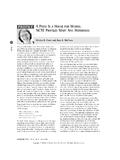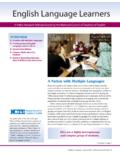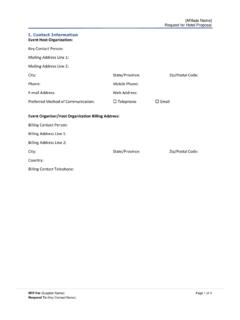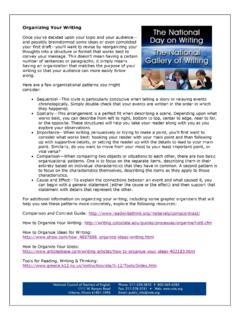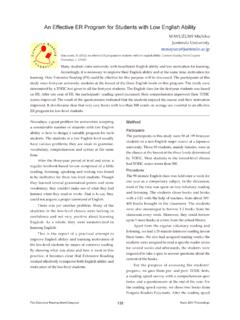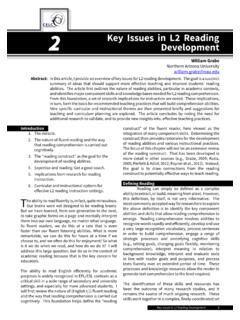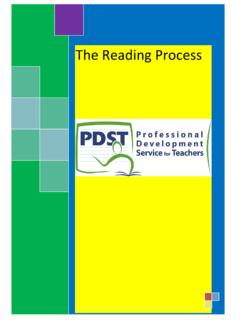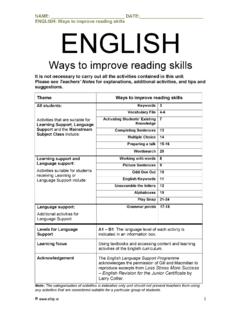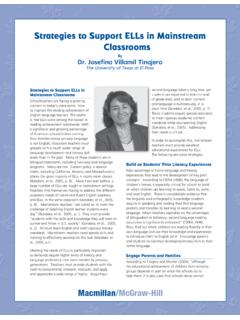Transcription of 12 The Middle School High Five: Strategies Can …
1 Page12 Voices from the Middle , Volume 13 Number 2, December 2005 Goodman | The Middle School high five : Strategies Can TriumphThe Middle School high Five: Strategies Can TriumphAmy GoodmanNo Child Left Behind. AdequateYearly Progress. high -stakestesting. Performance on grade level. Writing on de-mand. No matter where you turn ineducation today, language arts teachersare shouldering a lot of the responsibilityfor preparing students to pass state can it all get done in a 45-minutemiddle School period called LanguageArts?For those of us who teach this subject, we knowthat it can t all get done. Because of this, it is criti-cal that we manage our Middle School day in cre-ative ways so that students are taught and practicelanguage arts skills in all of their classes.
2 We knowthe jargon all too well: reading in the content ar-eas, interdisciplinary units, and writing across thecurriculum. Our challenges are supporting the staffand finding the time in all of our classes to make am the literacy support teacher for ninemiddle schools in the Anchorage School have about 7,500 students in our middleschools with 93 different languages spoken and amobility rate close to 20%. We are an urban dis-trict with all of the problems associated with ur-ban schools in the lower 48. We have miraculouslyheld on to our Middle School concept since its in-ception ten years ago even with district and statefunding crises year after year after year. Most ofour schools operate on a 7-period day.
3 Studentshave four core classes, PE, and two electives. Staffteach four periods of core subjects and one elec-tive. They have a planning period and a team plan-ning time. It is this team planning time that raiseseyebrows from those seeking educational budgetcuts each year, but it is also this team planningtime where critical coordination takes place tomake Middle schools function as they had spent two years emailing weekly literacytips to the language arts teachers random strat-egies from all of our best literacy leaders: JanetAllen, Linda Hoyt, Linda Rief, Jeff Wilhelm, anda host of others. Feedback was always positive, butI soon realized that I was going about this in thewrong way. With a plethora of Strategies fromwhich to choose, teachers were overwhelmed andinefficient, causing instruction to become hit ormiss.
4 From class to class, there was little consis-tency or curriculum alignment. It became appar-ent that strategy instruction needed to beorganized in such a way that it became the normand not the exception. Students deserved explicit,sequenced instruction from all of their teachersin a meaningful, connected way. In an effort toimprove reading comprehension as well as elevatethe importance of reading and writing in contentareas, I developed a districtwide staff developmentinitiative called the Middle School high Support for theMiddle School high FiveAt a spring districtwide meeting with all nine de-partment chairs present, I pitched the idea of theMiddle School high five . What if, I hypoth-esized, we chose five reading Strategies that weall agree improve comprehension.
5 We could rollout a strategy a week and get our content areateachers on board, too. If everyone were to sys-tematically use the same reading strategy during a12_19VM_Dec0511/10/05, 8:41 AM12page13 Voices from the Middle , Volume 13 Number 2, December 2005 Goodman | The Middle School high five : Strategies Can Triumphcertain period of time within their School , studentswould receive repeated practice on the strategy ina variety of settings and on a wide array of text, Isuggested. As heads began to nod, I continued, With our high mobility rate across the district,this coordination could help anchor our studentsas they move from School to School . Let s agree toteach five reading Strategies districtwide to see ifreading comprehension improves.
6 This idea of lessis more could actually help us work smarter andnot harder. The language arts department chairs werequick to agree to this initiative, and they sent meoff to the districtwide principals meeting to rallysupport. Strategies were selected that were alreadycommonly used in our schools and at the sametime reflected the different stages of the readingprocess: Around the Text, KIM Vocabulary, Two-Column Notes, Reciprocal Teaching, and VIPs/Sum It Up. By choosing before, during, and afterreading Strategies , content area teachers would notonly add specific Strategies to their toolkits butalso become more informed about reading as aprocess. Layered booklets were printed up withstep-by-step teacher-friendly explanations (seeFigure 1), which also included content area ex-amples.
7 Masters were made available electronicallyand sets of sturdy reciprocal teaching cards werecreated for the fourth strategy. All teachers, re-gardless of content area, would be able to teachthe five Strategies without any extra preparationtime to Launch the MiddleSchool high FiveI attended the content area districtwide meetingsto discuss the Middle School high five and togarner support in advance of our area teachers felt comfortable and agreedto teach these Strategies as long as they were firstintroduced to students via the language artsteacher on every team. One area of legitimate con-cern was the weeklong focus on each wanted at least a two-week window oneach since finding uninterrupted instructional timeis so challenging.
8 Determining an acceptable cal-Figure 1. Layered books distributed to teachers to explain the Middle School high five endar was no easy task either. In the end, it wasdecided to launch the Middle School high Fiveright after winter vacation when staff and studentsreturned to School with renewed energy. In astroke of good luck, there were actually ten in-structional weeks between winter break and springbreak. The fact that the Standards Based Assess-ments (Alaska s statewide tests) were scheduled forimmediately after spring break became the excla-mation point to this initiative. We would soonknow if the the Middle School high five wouldbetter prepare students for success on the state-wide used a pyramid model for staff develop-ment.
9 As winter vacation approached, I reviewedand modeled the five Strategies to the languagearts department chairs, who in turn went back totheir buildings and modeled the Strategies for theirlanguage arts teachers. It was expected that thelanguage arts teachers would meet with their re-spective teams and model these Strategies for othercontent area teachers during team planning School , however, asked me to model the strat-egies directly to the content area departmentchairs, who in turn would train the teachers in awareness meetings were held in Janu-ary at each School , cosponsored by the principal12_19VM_Dec0511/10/05, 8:41 AM13page14 Voices from the Middle , Volume 13 Number 2, December 2005 Goodman | The Middle School high five : Strategies Can Triumphand the department chairs.
10 Staff members wereintroduced to the principles of Middle SchoolHigh five , and materials such as the layered book-lets and reciprocal teaching cards were concise flyer was written so teachers walked awaywith a summary in hand as well as all materialsneeded to participate in the Middle School HighFive. The districtwide schedule of allocating twoweeks per strategy was delineated, and we beganthe following #1: Read around the TextTo ensure a strong start and build confidenceamong staff, my districtwide e-mail tips were sentnot only to the language arts teachers but to everymiddle School teacher. In this way, I could offereach teacher a more personalized account of thestrategy to be taught. Read around the Text (origi-nal idea from Melvina Prichett Phillips, NationalAssociation of Secondary Principals) was a per-fect beginning (see Figure 2).
